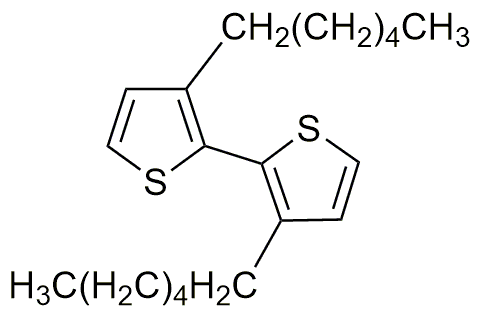3,3'-Dihexyl-2,2'-bithiophene is widely utilized in research focused on:
- Organic Photovoltaics: This compound is a key material in organic solar cells, enhancing light absorption and improving energy conversion efficiency, making solar energy more accessible and cost-effective.
- Organic Light Emitting Diodes (OLEDs): It serves as an important component in OLED technology, providing high brightness and color purity for displays in smartphones and televisions.
- Field-Effect Transistors (FETs): Used in the development of organic semiconductors, it contributes to the creation of flexible and lightweight electronic devices, which are increasingly in demand in the electronics industry.
- Sensors: This compound is applied in chemical sensors due to its sensitivity to environmental changes, aiding in the detection of pollutants and enhancing safety in industrial settings.
- Research in Material Science: It is utilized in studies aimed at developing new materials with tailored electronic properties, pushing the boundaries of innovation in various technological applications.
General Information
Properties
Safety and Regulations
Applications
3,3'-Dihexyl-2,2'-bithiophene is widely utilized in research focused on:
- Organic Photovoltaics: This compound is a key material in organic solar cells, enhancing light absorption and improving energy conversion efficiency, making solar energy more accessible and cost-effective.
- Organic Light Emitting Diodes (OLEDs): It serves as an important component in OLED technology, providing high brightness and color purity for displays in smartphones and televisions.
- Field-Effect Transistors (FETs): Used in the development of organic semiconductors, it contributes to the creation of flexible and lightweight electronic devices, which are increasingly in demand in the electronics industry.
- Sensors: This compound is applied in chemical sensors due to its sensitivity to environmental changes, aiding in the detection of pollutants and enhancing safety in industrial settings.
- Research in Material Science: It is utilized in studies aimed at developing new materials with tailored electronic properties, pushing the boundaries of innovation in various technological applications.
Documents
Safety Data Sheets (SDS)
The SDS provides comprehensive safety information on handling, storage, and disposal of the product.
Product Specification (PS)
The PS provides a comprehensive breakdown of the product’s properties, including chemical composition, physical state, purity, and storage requirements. It also details acceptable quality ranges and the product's intended applications.
Certificates of Analysis (COA)
Search for Certificates of Analysis (COA) by entering the products Lot Number. Lot and Batch Numbers can be found on a product’s label following the words ‘Lot’ or ‘Batch’.
Numéro de catalogue
Numéro de lot/série
Certificates Of Origin (COO)
This COO confirms the country where the product was manufactured, and also details the materials and components used in it and whether it is derived from natural, synthetic, or other specific sources. This certificate may be required for customs, trade, and regulatory compliance.
Numéro de catalogue
Numéro de lot/série
Safety Data Sheets (SDS)
The SDS provides comprehensive safety information on handling, storage, and disposal of the product.
DownloadProduct Specification (PS)
The PS provides a comprehensive breakdown of the product’s properties, including chemical composition, physical state, purity, and storage requirements. It also details acceptable quality ranges and the product's intended applications.
DownloadCertificates of Analysis (COA)
Search for Certificates of Analysis (COA) by entering the products Lot Number. Lot and Batch Numbers can be found on a product’s label following the words ‘Lot’ or ‘Batch’.
Numéro de catalogue
Numéro de lot/série
Certificates Of Origin (COO)
This COO confirms the country where the product was manufactured, and also details the materials and components used in it and whether it is derived from natural, synthetic, or other specific sources. This certificate may be required for customs, trade, and regulatory compliance.


